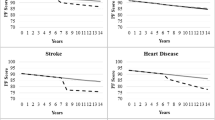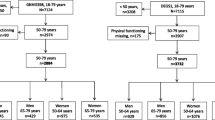Abstract
Background
Statin therapy may cause myopathy, but long-term effects on physical function are unclear.
Objective
We investigated whether statin use is associated with poorer physical function in two population-based cohorts of older adults.
Methods
Data were from 691 men and women (aged 69–102 years in 2005/2006) in the LASA (Longitudinal Aging Study Amsterdam) and 5912 women (aged 79–84 years in 2005) in the ALSWH (Australian Longitudinal Study on Women’s Health). Statin use and dose were sourced from containers (LASA) and administrative databases (ALSWH). Physical function was assessed using performance tests, questionnaires on functional limitations and the SF-12 (LASA) and SF-36 (ALSWH) questionnaires. Cross-sectional (both studies) and 3-year prospective associations (ALSWH) were analysed for different statin dosage using linear and logistic regression.
Results
In total, 25 % of participants in LASA and 61 % in ALSWH used statins. In the cross-sectional models in LASA, statin users were less likely to have functional limitations (percentage of subjects with at least 1 limitation 63.9 vs. 64.2; odds ratio [OR] 0.6; 95 % confidence interval [CI] 0.3–0.9) and had better SF-12 physical component scores (mean [adjusted] 47.3 vs. 44.5; beta [B] = 2.8; 95 % CI 1.1–4.5); in ALSWH, statin users had better SF-36 physical component scores (mean [adjusted] 37.4 vs. 36.5; B = 0.9; 95 % CI 0.3–1.5) and physical functioning subscale scores (mean [adjusted] 55.1 vs. 52.6; B = 2.4; 95 % CI 1.1–3.8) than non-users. Similar associations were found for low- and high-dose users and in the prospective models. In contrast, no significant associations were found with performance tests.
Conclusions
Two databases from longitudinal population studies in older adults gave comparable results, even though different outcome measures were used. In these two large cohorts, statin use was associated with better self-perceived physical function.

Similar content being viewed by others
References
Geleedst-De VM, Maitland-van der Zee AH, Schalekamp T, Mantel-Teeuwisse A, Jansen P. Statin prescribing in the elderly in The Netherlands: a pharmacy database time trend study. Drugs Aging. 2010;27(7):589–96.
Peeters G, Tett SE, Conaghan PG, Mishra GD, Dobson AJ. Is statin use associated with new joint-related symptoms, physical function and quality of life? The Australian Longitudinal Study on Women’s Health. Arthritis Care Res (Hoboken). 2015;67(1):13–20.
Baigent C, Keech A, Kearney PM, Blackwell L, Buck G, Pollicino C, et al. Efficacy and safety of cholesterol-lowering treatment: prospective meta-analysis of data from 90,056 participants in 14 randomised trials of statins. Lancet. 2005;366(9493):1267–78.
Bruckert E, Hayem G, Dejager S, Yau C, Begaud B. Mild to moderate muscular symptoms with high-dosage statin therapy in hyperlipidemic patients–the PRIMO study. CardiovascDrugs Ther. 2005;19(6):403–14.
Farmacotherapeutisch kompas. Zorginstituut Nederland. Available from http://www.farmacotherapeutischkompas.nl. Accessed 21 Aug 2014.
Tomlinson SS, Mangione KK. Potential adverse effects of statins on muscle. Phys Ther. 2005;85(5):459–65.
Pasternak RC, Smith SC Jr, Bairey-Merz CN, Grundy SM, Cleeman JI, Lenfant C. ACC/AHA/NHLBI clinical advisory on the use and safety of statins. Circulation. 2002;106(8):1024–8.
Haerer W, Delbaere K, Bartlett H, Lord SR, Rowland J. Relationships between HMG-CoA reductase inhibitors (statin) use and strength, balance and falls in older people. Intern Med J. 2012;42(12):1329–34.
Corsonello A, Garasto S, Abbatecola AM, Rose G, Passarino G, Mazzei B, et al. Targeting inflammation to slow or delay functional decline: where are we? Biogerontology. 2010;11(5):603–14.
Cham S, Evans MA, Denenberg JO, Golomb BA. Statin-associated muscle-related adverse effects: a case series of 354 patients. Pharmacotherapy. 2010;30(6):541–53.
Huisman M, Poppelaars J, van der Horst M, Beekman AT, Brug J, van Tilburg TG, et al. Cohort profile: the Longitudinal Aging Study Amsterdam. Int J Epidemiol. 2011;40(4):868–76.
Lee C, Dobson AJ, Brown WJ, Bryson L, Byles J, Warner-Smith P, et al. Cohort Profile: the Australian Longitudinal Study on Women’s Health. Int J Epidemiol. 2005;34(5):987–91.
Guralnik JM, Simonsick EM, Ferrucci L, Glynn RJ, Berkman LF, Blazer DG, Scherr PA, Wallace RB. A short physical performance battery assessing lower extremity function: association with self-reported disability and prediction of mortality and nursing home admission. J Gerontol. 1994;49(2):M85–94.
Gandek B, Ware JE, Aaronson NK, Apolone G, Bjorner JB, Brazier JE, et al. Cross-validation of item selection and scoring for the SF-12 Health Survey in nine countries: results from the IQOLA Project. International Quality of Life Assessment. J Clin Epidemiol. 1998;51(11):1171–8.
McCallum J. The SF-36 in an Australian sample: validating a new, generic health status measure. Aust J Public Health. 1995;19(2):160–6.
WHO Collaborating Centres for Drugs Statistics Methodology WHO/ATC index. 2013. [cited; Available from: http://www.whocc/nl/atc_ddd_index/.
Farmacotherapeutisch komas. Available from: http://www.farmacotherapeutischkompas.nl. Accessed 18 Aug 2014.
Bakhai A, Rigney U, Hollis S, Emmas C. Co-administration of statins with cytochrome P450 3A4 inhibitors in a UK primary care population. Pharmacoepidemiol Drug Saf. 2012;21(5):485–93.
Bongers IM, van Oers HA, van de Goor IA, Garretsen HF. Alcohol use and problem drinking: prevalences in the general Rotterdam population. Subst Use Misuse. 1997;32(11):1491–512.
Australian alcohol guidelines; health risks and benefits. National Health and Medical Research Council; 2001.
Stel VS, Smit JH, Pluijm SM, Visser M, Deeg DJ, Lips P. Comparison of the LASA Physical Activity Questionnaire with a 7-day diary and pedometer. J Clin Epidemiol. 2004;57(3):252–8.
Brown WJ, Burton NW, Marshall AL, Miller YD. Reliability and validity of a modified self-administered version of the Active Australia physical activity survey in a sample of mid-age women. Aust NZ J Public Health. 2008;32(6):535–41.
Scott D, Blizzard L, Fell J, Jones G. Statin therapy, muscle function and falls risk in community-dwelling older adults. QJM. 2009;102(9):625–33.
Ashfield TA, Syddall HE, Martin HJ, Dennison EM, Cooper C, Aihie SA. Grip strength and cardiovascular drug use in older people: findings from the Hertfordshire Cohort Study. Age Ageing. 2010;39(2):185–91.
Witham MD, Syddall HE, Dennison E, Cooper C, McMurdo ME, Sayer AA. ACE inhibitors, statins and thiazides: no association with change in grip strength among community dwelling older men and women from the Hertfordshire Cohort Study. Age Ageing. 2014;43(5):661–6.
Parker BA, Capizzi JA, Grimaldi AS, Clarkson PM, Cole SM, Keadle J, et al. Effect of statins on skeletal muscle function. Circulation. 2013;127(1):96–103.
Panza GA, Taylor BA, Dada MR, Thompson PD. Changes in muscle strength in individuals with statin-induced myopathy: a summary of 3 investigations. J Clin Lipidol. 2015;9(3):351–6.
Gray SL, Aragaki AK, LaMonte MJ, Cochrane BB, Kooperberg C, Robinson JG, et al. Statins, angiotensin-converting enzyme inhibitors, and physical performance in older women. J Am Geriatr Soc. 2012;60(12):2206–14.
Lo-Ciganic WH, Perera S, Gray SL, Boudreau RM, Zgibor JC, Strotmeyer ES, Donohue JM, Bunker CH, Newman AB, Simonsick EM, Bauer DC, Satterfield S, Caserotti P, Harris T, Shorr RI, Hanlon JT, Health, Aging and Body Composition Study. Statin use and decline in gait speed in community-dwelling older adults. J Am Geriatr Soc. 2014;63(1):124–9. doi:10.1111/jgs.13134.
Agostini JV, Tinetti ME, Han L, McAvay G, Foody JM, Concato J. Effects of statin use on muscle strength, cognition, and depressive symptoms in older adults. J Am Geriatr Soc. 2007;55(3):420–5.
Galindo-Ocana J, Bernabeu-Wittel M, Formiga F, Fuertes-Martin A, Baron-Franco B, Murcia-Zaragoza JM, et al. Effects of renin-angiotensin blockers/inhibitors and statins on mortality and functional impairment in polypathological patients. Eur J Intern Med. 2012;23(2):179–84.
Dumurgier J, Singh-Manoux A, Tavernier B, Tzourio C, Elbaz A. Lipid-lowering drugs associated with slower motor decline in the elderly adults. J Gerontol A Biol Sci Med Sci. 2014;69(2):199–206.
Lo-Ciganic WH, Perera S, Gray SL, Boudreau RM, Zgibor JC, Strotmeyer ES, et al. Statin use and decline in gait speed in community-dwelling older adults. J Am Geriatr Soc. 2015;63(1):124–9.
Cesari M, Penninx BW, Pahor M, Lauretani F, Corsi AM, Rhys WG, et al. Inflammatory markers and physical performance in older persons: the InCHIANTI study. J Gerontol A Biol Sci Med Sci. 2004;59(3):242–8.
Franceschi C, Capri M, Monti D, Giunta S, Olivieri F, Sevini F, et al. Inflammaging and anti-inflammaging: a systemic perspective on aging and longevity emerged from studies in humans. Mech Ageing Dev. 2007;128(1):92–105.
Ridker PM, Cannon CP, Morrow D, Rifai N, Rose LM, McCabe CH, et al. C-reactive protein levels and outcomes after statin therapy. N Engl J Med. 2005;352(1):20–8.
Hansen KE, Hildebrand JP, Ferguson EE, Stein JH. Outcomes in 45 patients with statin-associated myopathy. Arch Intern Med. 2005;165(22):2671–6.
Rengo JL, Callahan DM, Savage PD, Ades PA, Toth MJ. Skeletal muscle ultrastructure and function in statin-tolerant individuals. Muscle Nerve. 2016;53(2):242–51.
Anderson GD. Sex and racial differences in pharmacological response: where is the evidence? Pharmacogenetics, pharmacokinetics, and pharmacodynamics. J Womens Health (Larchmt). 2005;14(1):19–29.
Mangoni AA, Jackson SH. Age-related changes in pharmacokinetics and pharmacodynamics: basic principles and practical applications. Br J Clin Pharmacol. 2004;57(1):6–14.
DeGorter MK, Tirona RG, Schwarz UI, Choi YH, Dresser GK, Suskin N, et al. Clinical and pharmacogenetic predictors of circulating atorvastatin and rosuvastatin concentrations in routine clinical care. Circ Cardiovasc Genet. 2013;6(4):400–8.
Schwartz JB, Verotta D. Population analyses of atorvastatin clearance in patients living in the community and in nursing homes. Clin Pharmacol Ther. 2009;86(5):497–502.
Indications for statin use. Available from: http://www.fk.cvz.nl/inleidendeteksten/i/inl%20lipidenverlagende%20middelen.asp#indicaties. Accessed 2014.
Lowrie RLS, McConnachie A, Morrison J. A cluster randomised controlled trial of a pharmacist-led collaborative intervention to improve statin prescribing and attainment of cholesterol targets in primary care. PloS One. 2014;9:e113370.
Simons LACE. Are high coronary risk patients missing out on lipid-lowering drugs in Australia? Med J Aust. 2014;201:213–6.
Rowan CG, Brunelli SM, Munson J, Flory J, Reese PP, Hennessy S, et al. Clinical importance of the drug interaction between statins and CYP3A4 inhibitors: a retrospective cohort study in The Health Improvement Network. Pharmacoepidemiol Drug Saf. 2012;21(5):494–506.
Acknowledgments
The authors are grateful to the participants of both studies. LASA is largely supported by The Netherlands Ministry of Health Welfare and Sports, Directorate of Long-Term Care. ALSWH is funded by the Australian Government Department of Health. The research on which this paper is based was partly conducted in The Netherlands and partly in Australia as part of the Australian Longitudinal Study on Women’s Health, The University of Newcastle and The University of Queensland. We acknowledge the Department of Health and Medicare Australia for providing the PBS data, and the Australian Institute of Health and Welfare (AIHW) as the integrating authority for these data.
G. M. E. E. Peeters is currently employed by Monash University, School of Public Health and Preventive Medicine, Melbourne, Australia.
Author information
Authors and Affiliations
Corresponding author
Ethics declarations
Conflict of interest
Drs van Boheemen, Tett, Sohl, Hugtenberg, van Schoor, and Peeters declare they have no conflicts of interest that might be relevant to the contents of this manuscript.
Funding
This work was supported by The Netherlands Ministry of Health Welfare and Sports, Directorate of Long-Term Care, who funded the LASA; the Australian Government Department of Health, who funded the ALSWH; and an Australian National Health Medical Research Council Centre of Research Excellence Grant (Grant Number APP1000986, [GP]).
Electronic supplementary material
Below is the link to the electronic supplementary material.
Rights and permissions
About this article
Cite this article
van Boheemen, L., Tett, S.E., Sohl, E. et al. Associations Between Statin Use and Physical Function in Older Adults from The Netherlands and Australia: Longitudinal Aging Study Amsterdam and Australian Longitudinal Study on Women’s Health. Drugs Aging 33, 437–445 (2016). https://doi.org/10.1007/s40266-016-0370-5
Published:
Issue Date:
DOI: https://doi.org/10.1007/s40266-016-0370-5




